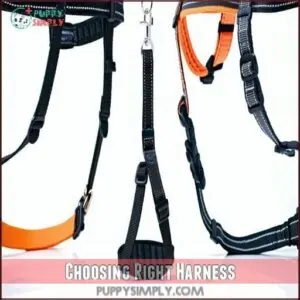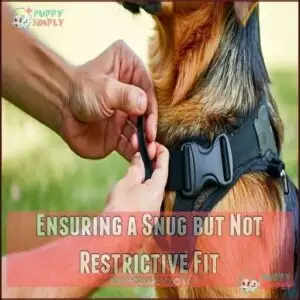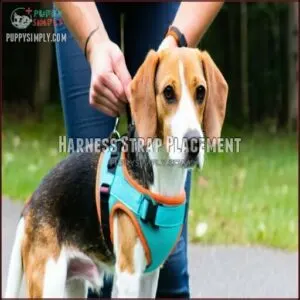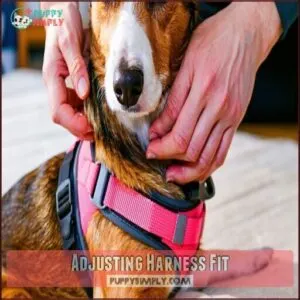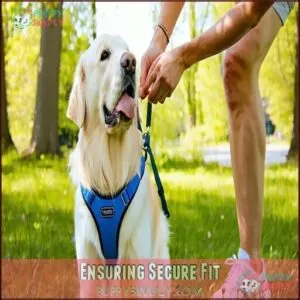This site is supported by our readers. We may earn a commission, at no cost to you, if you purchase through links.
 To put on a dog harness, start by choosing the right type for your dog’s size and activity.
To put on a dog harness, start by choosing the right type for your dog’s size and activity.
Have your dog sit or stand calmly. For an overhead harness, slip it over your dog’s head, then guide one leg through the first loop.
Buckle the straps, ensuring they’re snug but not too tight—you should fit two fingers between the harness and your dog. With a step-in harness, lay it flat, have your dog step into the openings, then pull it up and buckle.
Adjust straps evenly for comfort and mobility, and check frequently to keep it secure. Want a picture-perfect fit? Stay tuned!
Table Of Contents
- Key Takeaways
- Choosing Right Harness
- Putting on Dog Harness
- Measuring Dog Size
- Harness Strap Placement
- Adjusting Harness Fit
- Ensuring Secure Fit
- Frequently Asked Questions (FAQs)
- How to put on a dog harness correctly?
- How to put a harness on a dog easy walk?
- How to put on a perfect fit dog harness?
- How to put on top paw adjustable harness?
- How do you use a dog harness?
- How does a dog harness work?
- How do you use a vest dog harness?
- How do you stop a dog from wearing a harness?
- How do you put a dog paw on a harness?
- How do you attach a dog harness to a leash?
- Conclusion
Key Takeaways
- Pick the right harness for your dog’s size, breed, and activity to ensure comfort and safety.
- Always use the two-finger rule to check the fit; straps should be snug but not tight.
- Position the harness correctly, avoiding pressure on the throat and ensuring it doesn’t restrict movement.
- Regularly check and adjust the straps as your dog grows or their coat changes.
Choosing Right Harness
Finding the right harness guarantees your dog’s comfort and safety on every walk.
The perfect harness ensures every walk is comfortable, secure, and stress-free for both you and your dog.
Choose a design that matches your dog’s needs, body type, and personality for the best fit.
Selecting Standard Harnesses for Calm Dogs
A standard harness is a great choice for calm dog breeds, offering simplicity and comfort.
Look for durable materials and buckle safety features to guarantee a secure fit.
Reflective standard harnesses add visibility during nighttime walks.
Consider browsing a site for a quality standard dog harness for more options.
Proper harness fitting and adjustment are key to your dog’s comfort. Verify that two fingers fit underneath straps for a snug yet non-restrictive fit, ensuring a proper harness.
Choosing Step-in Harnesses for Energetic Dogs
A step-in harness is a lifesaver for energetic dogs.
A step-in harness keeps walks stress-free and fun, offering quick setup, durability, and escape-proof security for your energetic pup.
It’s quick to put on, durable, and secure, helping you focus on fun instead of wrangling. Its even pressure reduces chafing risks while ensuring escape prevention.
Look for breathable materials and adjustable straps for proper harness fitting. Many owners find a step-in dog harness particularly useful.
- Key features: Secure buckles, adjustable straps, breathable fabric
- Benefits: Escape prevention, reduced chafing risks
- Ideal for: Active dogs needing simple, durable harnesses
Front-Clip Harnesses for Training and Control
If your dog pulls like it’s training for a sled race, a front clip harness is your best friend.
The leash attachment on their chest discourages pulling by pivoting them toward you.
This training harness provides chest control, better focus, and safer walks.
Remember, proper harness adjustment is key—snug but not tight guarantees comfort and maximum training benefits.
Many owners find that no-pull harnesses can substantially aid training.
Overhead Harnesses for Specific Needs
For dogs with unique needs, like seniors or puppies, an over-the-head harness offers security and comfort.
It’s great for medical recovery or escape-prone pups.
Slide the neck loop on, adjust straps snugly, and guarantee mobility.
This style reduces anxiety while being user-friendly.
Proper harness adjustment is key—follow a harness fitting guide to keep your dog stress-free and safe.
Many owners find an overhead dog harness helpful for training.
Putting on Dog Harness
Getting a dog harness on your pup doesn’t have to feel like putting together a puzzle. Start with positive reinforcement—a treat or gentle words work wonders.
Follow the harness instructions carefully to avoid tangles. For step-in harnesses, lay it flat and guide your dog’s paws into the loops. For overhead designs, slip the neck loop over their head first.
Gently secure buckles and check the D-ring placement for leash attachment. Troubleshooting fits? Use a harness fitting guide to adjust the straps. A snug fit means two fingers can slide between the straps and fur.
Back-clip harnesses are ideal for casual walks. Practice sessions can help both you and your dog get comfortable with the process. Proper harness placement guarantees safety and control during walks.
Measuring Dog Size
Getting the right harness starts with properly measuring your dog’s size.
Focus on the girth and chest to guarantee a snug, secure fit that isn’t too tight or too loose.
Taking Accurate Measurements of Dog’s Girth and Chest
How do you measure for the perfect dog harness? First, grab a measuring tape.
Wrap it snugly around the widest part of the chest for the girth measurement. Next, measure chest depth from shoulders to sternum.
Accurate dog measurements prevent sizing mishaps. Remember, breed variations mean fit differs.
With the right tools, harness sizes become easy to match, and using the correct measurements is key to a perfect fit.
Ensuring a Snug but Not Restrictive Fit
When measuring your pup, it’s not just about size—it’s about comfort and safety.
Use the finger test: you should fit two fingers under the straps.
This guarantees proper fit and breathing room while preventing chafing or restriction.
Regularly check harness tightness and adjusting points over time for escape proofing and mobility assessment.
A snug yet flexible dog harness wins!
Calculating Ideal Harness Size
A proper fit starts with accurate dog harness measurements.
Wrap a tape snugly around your dog’s girth, just behind the front legs.
For growing dogs, allow room for growth.
Chest considerations, breed differences, and weight influence harness sizing.
Always check manufacturer size charts.
If in doubt, opting for the larger size guarantees comfort and easier harness adjustment tips later.
Harness Strap Placement
Proper harness strap placement is key to ensuring your dog’s comfort and mobility.
Make sure the straps avoid the throat, sit below the neck, and don’t restrict the shoulders or legs, as proper placement is crucial for your dog’s well-being.
Positioning Straps for Comfort and Mobility
Once you’ve measured your dog, focus on placing the harness straps just right.
Straps should fit below the neck to avoid sensitive pressure points, and avoid crossing joints to keep mobility easy.
A proper fit prevents chafing and discomfort.
Adjust for your dog’s breed and material type, using the harness’s adjusting points to balance secure comfort with freedom of movement.
Avoiding Pressure on Dog’s Throat
Make sure the harness doesn’t press on your dog’s throat.
Position straps below the neck and on the chest bone to prevent neck strain.
A good design like a Y-harness avoids sensitive areas.
Keep it snug—not tight—to guarantee comfort and safety.
This protects breeds prone to throat issues.
Proper training techniques also help reduce pressure.
Some owners prefer harnesses because they distribute pressure evenly.
Preventing Shoulder and Leg Stride Inhibition
To keep your dog’s stride natural, make certain the harness rests behind their front legs without touching shoulder joints.
Poor placement can restrict movement or alter gait.
Use this harness adjustment guide: check for shoulder room, allowing natural mobility.
Regular gait observation helps spot restriction signs early.
A well-fitted harness design enhances dog comfort, movement, and safety, and is crucial for maintaining a natural stride.
Adjusting Harness Fit
Making sure your dog’s harness fits correctly is key to their comfort and safety. Regular adjustments prevent irritation and guarantee it stays secure as your dog grows or changes shape.
Regularly Checking Harness Fit
Check your dog harness often for changes in fit.
Growth considerations and weight fluctuations can affect snugness.
Seasonal adjustments, like thicker winter coats, may also impact comfort.
Use harness fitting tips to guarantee two fingers slip under straps.
Inspect for hardware integrity and abrasion assessment.
These dog harness tips help avoid discomfort, keeping your pup safe and secure.
Adjusting Straps Based on Dog’s Body Changes
Over time, your dog’s body changes—whether it’s puppy growth, weight fluctuation, or seasonal changes.
Adjust your dog harness frequently to keep the fit just right.
Follow these harness fitting tips:
- Loosen all straps before adjustments.
- Align straps flat to prevent rubbing.
- Allow a two-finger gap under each strap.
Harnesses offer better comfort and safety compared to traditional collars, which is a key factor for better comfort.
- Recheck for proper fit after muscle gain or breed-specific growth, ensuring a proper fit and considering seasonal changes.
Securing Buckles Correctly and Evenly
Once your dog’s harness is adjusted, focus on securing the buckles correctly and evenly.
Flatten straps to avoid twisting, then snap the buckles snugly. Listen for clear "clicks" to confirm secure fastening—no guessing games here!
For even tension across the harness, double-check each strap. Uneven pressure can cause discomfort or slipping.
Here’s a quick guide:
| Tip | Action |
|---|---|
| Buckle Integrity | Test each buckle for a strong click. |
| Avoid Twisting | Smooth out straps before buckling. |
| Secure Fastening | Confirm buckles are locked firmly. |
| Even Tension | Adjust straps for balanced pressure. |
| Harness Security | Tug gently; harness shouldn’t shift. |
Ensuring Secure Fit
You need to make sure your dog’s harness is snug but not too tight, so it stays secure without causing discomfort.
A proper fit prevents slipping, rubbing, or choking, keeping your dog safe and happy on every walk.
Final Check for Comfort and Safety
A quick final check confirms your dog’s safety and comfort.
Follow these steps:
- Test mobility by letting your dog walk—watch for any movement restrictions.
- Prevent chafing by adjusting straps for two-finger spacing.
- Verify buckle security by lightly tugging on straps.
- Verify it’s escape-proof by gently pulling the harness upward—watch your dog’s calm reaction during this harness fitting tutorial.
Your dog’s safety is the top priority, and these steps ensure that.
Avoiding Common Mistakes When Putting on a Harness
Don’t underestimate the small stuff. Skipping a harness fitting tutorial or ignoring buckle safety can lead to escape risks or chafing.
Always check for incorrect orientation—straps twisted? Redo!
Fit consistency matters; loose harnesses invite escapes, while tight ones cause discomfort.
A proper harness comfort guide guarantees your dog’s safety and freedom, keeping walks pleasant and secure.
Maintaining a Proper Fit Over Time
As your pup grows or tackles new adventures, check the dog harness regularly for wear and tear.
Growth adjustments and seasonal changes—like shedding or thicker coats—can impact fit. Look for fit indicators like sliding straps or skin marks.
Use adjustable straps for harness adjustment advice and guarantee dog safety. Always prioritize dog comfort during routine checks, keeping activities stress-free.
Frequently Asked Questions (FAQs)
How to put on a dog harness correctly?
Did you know harness fit issues cause 80% of escape cases?
Start by choosing the right type, adjust straps snugly (two-finger rule), and check placement.
Stay calm and make it a positive experience for your dog!
How to put a harness on a dog easy walk?
Position the Easy Walk harness with the chest strap across your dog’s chest and the belly strap beneath.
Clip the straps together near the shoulders, adjust for a snug fit, and verify the front leash ring faces forward.
How to put on a perfect fit dog harness?
Start by placing the smaller neck loop over your dog’s head.
Secure the chest and belly straps, ensuring the Perfect Fit harness sits snugly but comfortably.
Adjust straps for a proper fit, allowing two-finger spacing.
How to put on top paw adjustable harness?
Lay the harness flat with straps open.
Slip it over your dog’s head, ensuring the D-ring sits on their back.
Adjust straps under the belly, buckle securely, and check for a snug, two-finger fit.
How do you use a dog harness?
Imagine walking a lively pup who tugs everywhere.
A dog harness keeps them safe and you in control.
Slip it on as designed, adjust straps snugly, and attach the leash securely.
Enjoy stress-free strolls!
How does a dog harness work?
A dog harness works by evenly distributing pressure across your dog’s chest and shoulders instead of their neck, giving you better control during walks.
It’s safer, especially for dogs that pull, and reduces choking risks.
How do you use a vest dog harness?
Slip the vest harness over your dog’s head, verifying the D-ring rests on their back.
Pull the bottom straps under their belly, fasten securely, and adjust straps.
Verify a snug fit with two fingers of space.
How do you stop a dog from wearing a harness?
To stop your dog from wearing a harness, gently unbuckle it and guide it off your dog.
If they’re nervous, keep them calm with treats or soothing words.
Always remove it in a stress-free environment.
How do you put a dog paw on a harness?
Getting a paw into a harness can feel like threading a needle, but it’s simple.
Place their paw gently into the loop while they’re standing calmly, then lift and secure the harness snugly.
How do you attach a dog harness to a leash?
Clip the leash’s clasp to the leash attachment point on the harness, usually a D-ring.
Tug gently to confirm it’s secure.
Always double-check it’s fastened properly to keep your pup safe during walks.
Conclusion
Ready to master how to put on a dog harness with ease?
Following these simple steps guarantees your pup stays comfortable, secure, and ready for any adventure.
Remember to choose a harness that suits your dog’s size and needs, adjust the straps for a snug fit, and check frequently for comfort.
A well-fitted harness improves mobility and keeps your dog safe during walks.
Now you’re set to get out there and enjoy quality time with your furry friend!

